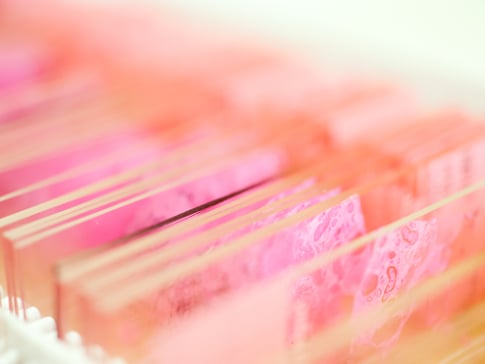Scientists have used a protein from Mycobacterium tuberculosis – the bacterium that causes most cases of tuberculosis – to unravel the signals produced by cancer from those of healthy cells.
A team at The Institute of Cancer Research, London, used the M. tuberculosis protein to help untangle the complex communication network between breast cancer cells and their healthy neighbours – and begin to describe breast cancer’s communication signature.
The research, funded by the Wellcome Trust and Cancer Research UK, used the bacterial protein as part of a new method to mark up the signals produced by cancer cells and healthy cells differently, so that they could be told apart.
Understanding the origin of different cell signals will illuminate the processes involved in driving cancer and could lead to new forms of treatment.
Breast cancer cells communicate with each other, and with neighbouring cells from the healthy breast, through a hugely complex network of interactions that helps drive the tumour’s growth and ensure it is nourished as it develops. Up to now, it has not been possible to easily tell apart the signals sent out by different cell types.
But the new method, described in the journal Molecular and Cellular Proteomics, was able to separate out signals from breast cancer cells from those of a type of healthy cell called fibroblasts, and could be applied to a wide range of different cancers.
Researchers took advantage of a quirk in the natural production of lysine, one of the 22 amino acid building blocks that make up all the proteins in the human body.
The final form of lysine is made by two different enzymes – diaminopimelate decarboxylase (DDC) and lysine racemase – each of which works on a different precursor molecule.
Scientists grew breast cancer cells containing DDC taken from M. tuberculosis for 10 days in a petri dish – causing the cells to produce 90 per cent of their lysine from one particular of the two precursors (called meso-2,6-Diaminopimelate).
Conversely, healthy human cells grown in a medium containing lysine racemase – produced by another bacterium called Proteus mirabilis – produced 90 per cent of their lysine from the second precursor, D-lysine.
Scientists grew both cell types in a medium containing ‘heavy’ D-lysine so proteins making use of this precursor could be told apart from those using the other – separating out signals produced by healthy cells and those produced by breast cancer. The heavier lysine could be distinguished from lighter lysine using a technique called mass spectrometry.
Study leader Dr Chris Tape, Sir Henry Wellcome Postdoctoral Fellow at The Institute of Cancer Research, London, said:
“Cancer cells send out signals to other cells in their surroundings, and the effects produced by these signals play an important role in a tumour’s development. The signals released by cancer cells and their healthy neighbours form an extremely complex communication network, and we need new ways of unpicking the cellular origins of the various signals so we can better understand what is happening.
“Our new method can discriminate between the signals produced from breast cancer cells and their healthy neighbours, and is allowing us to begin to describe breast cancer’s distinctive communication signature. Understanding how cancer signals to its surroundings could have a wide range of applications in the future, including in identifying potential targets for new treatments.”
Nell Barrie, science information manager at Cancer Research UK, said:
“Cancer cells are constantly communicating and this technique offers an ingenious new way to listen in on their signals. Taking inspiration from tuberculosis research also highlights the power of collaboration across different fields in science – Cancer Research UK is investing in this collective approach to science through our involvement in the Francis Crick Institute, which will bring together scientists from many areas of health research when it opens in London in 2015.”
--ENDS--
For more information contact the ICR press office on 020 7153 5582 / [email protected]. For enquiries out of hours, please call 07708 516357.
Notes to editors
The Institute of Cancer Research, London, is one of the world’s most influential cancer research institutes.
Scientists and clinicians at The Institute of Cancer Research (ICR) are working every day to make a real impact on cancer patients’ lives. Through its unique partnership with The Royal Marsden Hospital and ‘bench-to-bedside’ approach, the ICR is able to create and deliver results in a way that other institutions cannot. Together the two organisations are rated in the top four cancer centres globally.
The ICR has an outstanding record of achievement dating back more than 100 years. It provided the first convincing evidence that DNA damage is the basic cause of cancer, laying the foundation for the now universally accepted idea that cancer is a genetic disease. Today it leads the world at isolating cancer-related genes and discovering new targeted drugs for personalised cancer treatment.
As a college of the University of London, the ICR provides postgraduate higher education of international distinction. It has charitable status and relies on support from partner organisations, charities and the general public.
The ICR’s mission is to make the discoveries that defeat cancer. For more information visit www.icr.ac.uk.
